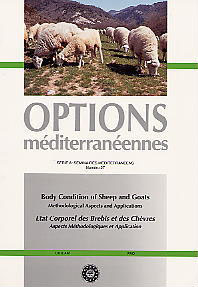| Article précédent | p. 197-202 |
Classification and composition of the carcass of pre-ruminant kid goats of the Granadina breed
To establish the principal relationships existing between carcass classification and composition in pre-ruminant kid goats of the Granadina breed, 36 kids were divided into nine groups, each of which was fed from birth until two months of age on different milk replacers. At two months of age all animals were slaughtered. The differences in the composition of the milk replacers used gave rise to different rates of food intake and different growth rates and to carcasses which differed in both chemical and tissue composition. The parameters of composition and classification, together with the variables energy intake, growth rate and carcass weight, were analysed by multivariate factor analysis. The results of the analysis indicated that three, to a certain extent, independent factors need to be taken into account when considering carcasses from animals of this type. The first of these is energy intake, which is the principal factor determining tissue composition. The second is the subcutaneous fat status of the carcass, which, in turn, is determined mainly by the carcass size, and the third is the carcass conformation which only in part, is dependent on the carcass weight.
- [ Afficher ]
- [ Télécharger ]
- [ Exporter la citation ]
Vous pouvez télécharger la citation au format :
- [ Imprimer ]
-
Mots-clés
CHEVREAU, COMPOSITION DE LA CARCASSECiter cet article
Sanz M.R., Ruiz I., Gil F., Boza J. Classification and composition of the carcass of pre-ruminant kid goats of the Granadina breed. In : Purroy A. (ed.). Body condition of sheep and goats: Methodological aspects and applications . Zaragoza : CIHEAM, 1995. p. 197-202. (Options Méditerranéennes : Série A. Séminaires Méditerranéens; n. 27). Seminar of the Working Group on Body Condition of Sheep and Goats of the FAO/CIHEAM Network on Sheep and Goats, 24-31 Mar 1994, Zaragoza (Spain). http://om.ciheam.org/om/pdf/a27/96605610.pdf



